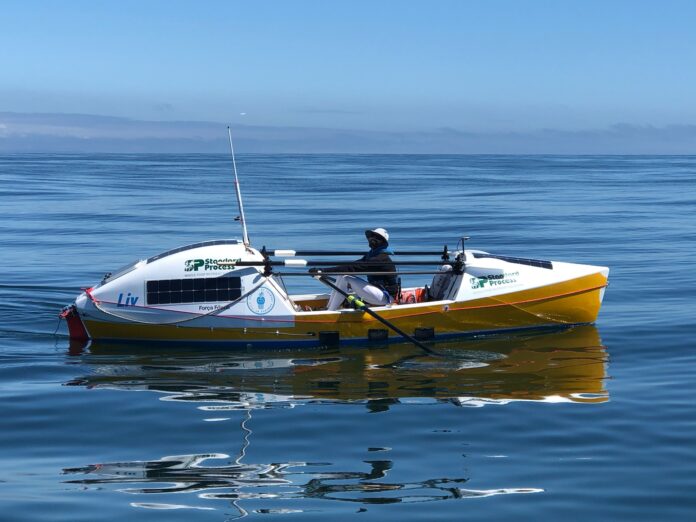Carlo Facchino, a 1994 UC Davis graduate, rowed from San Francisco to Hawaii in attempt to beat record set in 2014
By JADE BELL – campus@theaggie.org
UC Davis alumnus Carlo Facchino set out on his 2,400-mile row from San Francisco’s Golden Gate Bridge to Hawaii at 8:30 a.m. on July 5 and completed it on Sept. 15, 72 days later.
Prior to this, Facchino competed in the Great Pacific Race with Team Uniting Nations from Monterey to Hawaii in 39 and a half days, a Guinness World Record, with a four-man crew. In 2017, Fachinno rowed to the edge of the Arctic ice pack — the northernmost latitude ever reached by an ocean rowing boat — with a six-man crew. But for this row, Facchino set out alone in an attempt to beat a prior record for the row across the Pacific.
“My primary goal is to safely cross the Pacific with the hope of completing the row between 50 and 70 days,” Facchino said on his website before the row began. “I would love to try and break the solo record set by Rob Eustace in 2014 at 52 days, 13 hours, and 17 minutes.”
The challenges Facchino faced on his row go beyond the sheer distance of the journey. Specifically, a big challenge was managing his nutrition on the row, according to his website. By partnering with the Nutrition Innovation Center in North Carolina, Faccino’s fitness was tracked by three factors: pre-row fitness, performance capacity and nutritional levels.
Facchino explained on his website that he collected weekly blood samples throughout the row in order to see how his body and immune system adapted to the extreme endurance event.
Betsy Everett, Facchino’s rowing manager, explained how Facchino prepared for the brown through nutrition management and a workout regimen.
“We carefully planned and packed Carlo’s daily rations with the appropriate calorie and nutritional needs, which was a crucial step in helping him manage his nutrition for the row,” Everett said via email.
Everett also shared that managing Facchino’s nutrition was a collaborative effort between Facchino and his team. He self-regulated his needs and was able to communicate those needs with his rowing support throughout the trip.
“Land support and his medical director are in regular communication with Carlo and we rely on his self-reporting about what he has been eating,” Everett said while Facchino was in the middle of the row. “Each day’s food and nutrition is packed separately so it is easy for him to know what he should be eating each day. We check in regularly to talk through the amount of food he has left and what he has been eating each day, as well as how he is feeling and any [medical] issues that may come up.”
In addition to following a nutrition plan, Facchino maintains a year-round workout regimen that incorporates CrossFit workouts, running, erging and long-distance rowing, according to Everett.
In addition to the fitness level required to complete long-distance rows, Everett explained that rowers have to learn to manage watercraft and navigate ocean waters.
“Carlo has had to become an expert at knowing how everything on his boat operates and works,” Everett said. “He has needed to learn skills to become a mechanic, electrician, navigator, doctor as well as an athlete.”
Issues that arise on the water, according to Everett, must often be addressed with creative problem-solving since they are hard to predict.
“I found myself watching a 60-minute video online at 11:30 pm one night trying to learn how to untangle a specific kind of parachute anchor,” Everett said. “So I could pass on the instructions to Carlo in the middle of the night, so he would be able to stabilize his boat again and hopefully avoid a capsize.”
Even with Facchino’s level of expertise, completing a row of this kind requires a large team.
“The main, everyday team […] consists of his weather router who provides daily weather information and waypoints to get him into the best conditions to row [and] his medical director and backup EMT who helped plan Carlo’s med kit and training,” Everett said. “And then myself as his mainland support contact, as well as manager of communications, his social media, and logistics for his trip and arrival in Hawaii. This main team is essentially on call 24/7 for the duration of his trip in case of an emergency.”
Everett explained that in addition to providing practical support, this daily team focused on keeping morale up throughout the over two months Facchino was on the water.
“Emotions can run pretty raw when out there on the ocean by yourself for so long, so it has been pretty easy to sense when Carlo may need a little pick me up,” Everett said. “We continue to remind him on a regular basis that he can, and is doing this! […] Carlo is an incredible man and for the most part, he has remained positive and determined throughout the row.”
According to his website, issues like bad weather conditions and a broken water maker contributed to Facchino’s inability to beat the 2014 rowing record during this trip. However, he did manage to complete the row.
“I would like to thank everyone who has lent a hand, cheered me on, encouraged me and supported me in my endeavor,” Facchino said on his Facebook page. “Your support has meant the world to me. Making it to the start line of a grand adventure IS an adventure in itself.”
For specifics regarding Carlo’s row, the FaceBook page linked here includes daily updates from Carlo himself that he posted during the row.
Written by: Jade Bell — campus@theaggie.org





